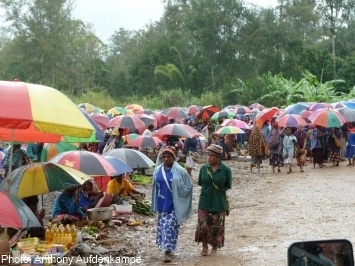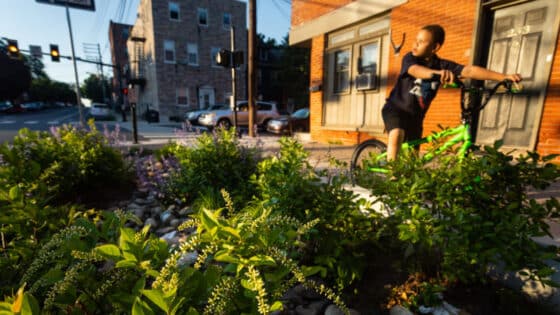This is the third article in a series on Stroud™ Water Research Center’s scientific expedition to the Fly River in Papua New Guinea. To read the articles in order:
- Pursuing Science Half a World Away: The Fly River in Papua New Guinea
- Unearthing Buried Treasure in Papua New Guinea
- River Are Not Pipes
By Patricia McAdams

“Hey! What are you doing?”
Across a muddy river in the mountains of Papua New Guinea — mountains he had been warned to avoid — Anthony Aufdenkampe, Ph.D., stopped filling his bucket with samples of soil and river sediment and looked at the man waving his arms and shouting angrily to him.
The man raced across a nearby bridge, continuing to yell, and attracting a crowd. Aufdenkampe wondered if he had been foolish to ignore the word on the street — that for a foreigner to go into these mountains would be risky.
The Internet and the media warned to stay out, but Aufdenkampe had traveled 11,000 miles on a shoestring budget from the National Science Foundation (NSF) to conduct research on these rivers and had come too far to not try.
“If we didn’t go into the mountains, we would be throwing away a golden opportunity,” he says. “No earth scientists have ever been here before.” But here he was now, with his colleague, Miguel Goni, Ph.D., not knowing what to expect.
Aufdenkampe, director of organic and isotope geochemistry at the Stroud™ Water Research Center, had set out two weeks earlier with an international team of scientists to gain an understanding of the transformation of river-borne carbon and other materials from the sources of the Fly River in Papua New Guinea to its sink. They wanted to prove that rivers were not pipes — that whatever came out of the mouth of a river was not the same as what went in at its source.
Recent studies found that more than half of the carbon and sediment discharge on Earth is coming off Oceania — a region around the South Pacific islands that includes the Gulf of Papua, at the mouth of the Fly. This site was, therefore, of special interest to the scientific community in understanding how these processes work on a global level. Of special concern are materials being dumped into the Fly River by two huge mines in the mountains.
“We needed to go up into the mountains to get to the source, so we could understand what happens in the entire river system,” says Aufdenkampe.
But ethnic tension had long been a problem among many traditional tribes in Papua New Guinea. Hostility was especially high throughout the lush but rugged cloud-covered mountains. At 8,000 feet or more, tribes remained largely isolated, not only from the outside world, but from one another as well.
According to one source, though, elections in 2007 had stabilized Papua New Guinea. Supposedly, inter-tribal warfare had ceased, so that sounded promising. Aufdenkampe believed that if he could just get to know the villagers, he would be safe. They hired a driver to take them to these dangerous areas and soon approached a totally muddy river not far from one of the mines.

It was exactly what they were looking for. They just had to be quick about collecting samples. They weren’t quick enough, however, and had been spotted by the irate man across the river. By the time Aufdenkampe and Goni got back to the bare-bones Toyota Land Cruiser they had rented, a crowd had gathered. The angry man was fast approaching, and their driver was nervously passing cigarettes around, trying to appease the crowd.
WHY TROPICAL RIVERS MATTER
“Historically, it had been assumed by many scientists that whatever came out of the mouth of a river was the same as what went in at its source,” Aufdenkampe says. “But those of us who study rivers said ‘No.’ There is plenty of evidence that rivers are not just pipes. And tropical rivers are especially important because most of the sun’s energy and rainfall happens near the equator.
“Papua New Guinea, in fact, has an insane amount of rainfall,” he says. “New satellite data shows that a stunning 25 percent of land in the tropics is underwater at some point in a typical year that is not a flood year.”
Here, along the Pacific rim of fire, steep mountains rise abruptly out of the sea, triggering heavy rains and erosion. Carbon and minerals from terrestrial ecosystems sweep into rivers, where carbon may be buried, respired as CO2, or transported to the ocean.
There are many places in the world with Papua New Guinea-like landscapes, so the Fly River is representative of other rivers draining this type of terrain. Yet scientists know little about them.
“We are hoping to learn what exactly is the difference between the organic materials that enter the river where it starts and where it leaves the river system — or gets buried. That difference tells us how the river ultimately affects the greenhouse gases.”
Accompanying Aufdenkampe to Papua New Guinea was Goni, from Oregon State University; Rolf Aalto, Ph.D., and Michael Grenfell from the University of Exeter in the UK; and Wes Lauer, Ph.D., from Seattle University. All five spent two weeks together in the lowlands. At this point, Aalto, Grenfell, and Lauer headed upstream to the foothills near one of the two mines. Aufdenkampe and Goni split with their team to travel instead east up into the heart of the mountains, near the other mine, and the headwaters of the Strickland River, which flows into the Fly.
THE GOLDEN TICKET
Back at the Toyota, the angry man approached Aufdenkampe and demanded, “What are you doing here?”
Aufdenkampe told him they were independent scientists studying the effects of nature and mining on the Fly, which had a magically calming effect on everyone. Evidently, the local council of tribe elders in the region had been asking for independent scientists to come evaluate the impacts of the mines on their land and water.
“The fact that we were not paid by the mines was a golden ticket,” so with the blessing of the people in one village after another, Aufdenkampe and Goni proceeded on their research expedition.
“The mine is literally ripping down the mountains,” says Aufdenkampe. “There are incredible piles of ore with what is actually liquid dirt oozing from these piles into the forest valley below. Whole forests are overwhelmed by mud. In fact, the forest valley is covered completely by sediment with maybe a little trickle of water going down the center. All that is visible of the vegetation in this once beautiful rainforest are bare tree tops poking out like sticks from the mud.”
THE RIGHT TO KNOW
According to Aufdenkampe, the people of Papua New Guinea have an appreciation for the value of resource extraction in producing jobs and roads in their country. But they ask, “What is this going to cost us environmentally?”
Interestingly, in each of the many villages Aufdenkampe visited, there was someone who had gone on for higher education, was aware of scientific concepts, and how scientific measurements were made. Yet they had been excluded from scientific meetings about water quality and related issues in Papua New Guinea. They asked for advice from Aufdenkampe and Goni, as they were not on the payroll of the mines or government, but had some expertise.
“As professionals, we thought we should provide them with information, so they could make informed decisions and decide for themselves what to do with their own country.”
MAKING FRIENDS

A rainy market day in a village in the Southern Highlands, on the road to Tari.
Although Aufdenkampe says traveling to unfamiliar territory rumored to be dangerous is scary, he adds that the people of Papua New Guinea are really nice, interesting, and friendly people — despite everything you might hear.
“What this trip really highlighted for me is that when you get to know them, there are good people everywhere. They want to do the right thing. And they care about their children.”
FINDING ANSWERS
Aufdenkampe and his colleagues made a giant step forward in collecting samples and other data that will help them unravel some of the mysteries of how river processes affect greenhouse gases on the global scale. But this is only a beginning, he says.
“I have a really strong desire to go back to Papua New Guinea one day to take up where we left off.”


